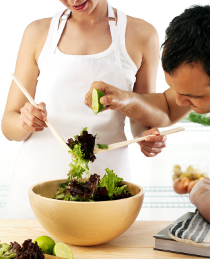4 Healthier Choices for Salad Dressings

But you’re sabotaging your weight loss efforts by adding tons of high-calorie salad dressing to all those low-calorie vegetables.
Some salad dressings have as much as 162 calories per serving size (two tablespoons).
You're better off using those extra calories on foods that will fill you up.
Salad Dressings To Avoid When Cutting Calories & Losing Weight
When it comes to salad dressings, the ones to avoid are:
- Caesar Dressing, Regular: 162 calories
- French Dressing: 138 cals
- Russian Dressing: 107 calories
- Ranch Dressing: 148 calories
Basically, anything rich and creamy tends to be empty calories.
Getting the low fat versions of these salad dressings might save you calories. But they aren’t healthier.
Low fat salad dressings replace the fat with sugar. Added sugar is NOT eating healthier.
See: How to Eat Less Sugar and Lose Weight
There are plenty of healthy ways to add flavor to a salad without using salad dressing.
And yes, you can eat a salad without dressing. The key is to fill your salad with flavorful ingredients.
What Should You Use Instead of Salad Dressing
There are plenty of healthy alternatives to salad dressing. Here are my four favorite substitutes:
1) Make a Basic Oil and Vinegar Dressing -- and Add Your Favorite Flavors
One option is to whisk together olive oil or flaxseed oil with red wine or balsamic vinegar. My favorite combination is olive oil with balsamic vinegarWhile olive oil and flaxseed oil have fat and calories, they are a healthy source of fat that your body needs.
Some recipes call for a ratio of three parts oil to one part vinegar. If you find it’s too much oil for your taste, you can reduce it to two parts oil to one part vinegar. Or even equal parts. I usually do equal parts.
You can spice up the oil and vinegar mixture by adding different types of flavoring to the vinaigrette.
You can add:
- Chopped, fresh herbs like basil, oregano or parsley.
- Different spices like cumin or red pepper flakes.
- Minced onions and garlic (shallots add a sweet flavor while a red onion packs a powerful punch)
- Dijon mustard and honey for a sweet yet tart flavor
- Lemon or lime juice to brighten up the other flavors in the salad.
For example, Ina Garten adds Dijon mustard to a simple oil and vinegar dressing.
Here are three basic recipes to get you started:
If you’re feeling adventurous, you can make up your own salad dressing with your favorite flavors. Kitchen Treaty has an informative guide that runs you through the basics: How to Make a Simple Vinaigrette Salad Dressing
You can find all kinds of recipes online. My favorite recipe sites are The Food Network, All Recipes and Epicurious.
2) Add a Squeeze of Lemon Juice (or Lime Juice)
Another way to dress up your salad without adding extra fat is to squeeze a little fresh lemon juice on your salad. It gives it a tart sweetness that adds a zing to your salad.See: 10 Delicious Ways to Spice Up a Salad
3) Roast or Saute Your Salad Vegetables
Who says salads have to be raw? Some of the best salads I’ve eaten use roasted or sauteed ingredients vegetables for extra flavor and texture.You can also roast, grill or saute vegetables like:
- Caramelized onions
- Grilled asparagus
- Roasted red peppers
- Zucchini
- Green beans
- Brussel sprouts
- Red or yellow beets
- Mushrooms
- Carrots
That’s not an exhaustive list. You can do it with basically any vegetable you love.
See: Raw or Cooked Vegetables - Which One is Best for Weight Loss?
4) Add Fruit to Your Salad
Another way to make a salad healthy without dressing is to add fruit to your salad. Yes, fruit!Mandarin orange slices (fresh or canned in water; not syrup) add a tangy, sweet flavor to a salad.
Grilled pineapple adds a peppery flavor with a bit of a crunchy texture.
You can add any fruit you like to a vegetable salad. There are no set rules.
One great tip to save money is to go with fruits that are in season.
Fruits you can add to a vegetable salad:
- Apricots
- Mangoes
- Grapes
- Asian pears
- Berries
- Apples
- Pomegranate seeds
- Clementines
- Oranges
I’m getting hungry for a salad just writing this!
So, as you can see, there’s really no need to use unhealthy salad dressings when making a healthy salad. There are simple substitutes for processed, unhealthy salad dressings that you can easily make with ingredients you have in your house.
HOW TO PUT THIS INTO PRACTICE
Here are some ideas to put these tips into action:
- Buy a good quality olive oil and balsamic vinegar.
- Roast, grill or saute your vegetables on Sunday and plop them into your salads during the week.
- Make your salad dressing on Sunday, too. Store it in a tightly closed jar or container in your fridge. Shake well before using.
- Use fresh lemons and limes. Zest a bit of the peel into your salad or into the dressing for extra flavor. Fresh lemon/lime juice is so much better than bottled.
- Buy already-made and washed salad in a bag. Then pimp it up with roasted veggies.
- Explore different salad dressings each week to keep your taste buds motivated.
Related Articles
How to Eat More Vegetables
Top 5 Healthy Dark Green Vegetables
11 Golden Rules to Healthier Eating
